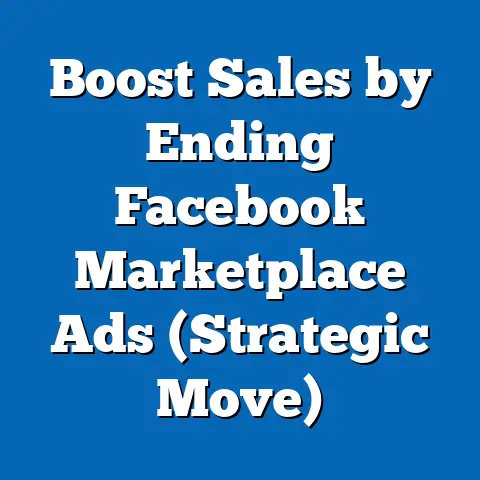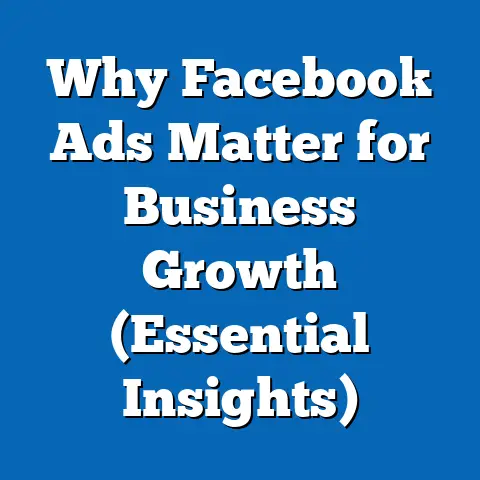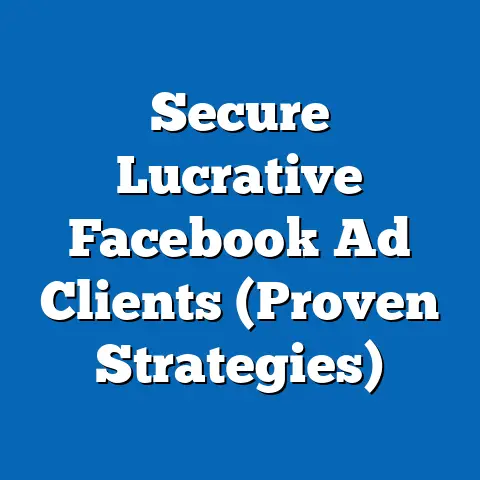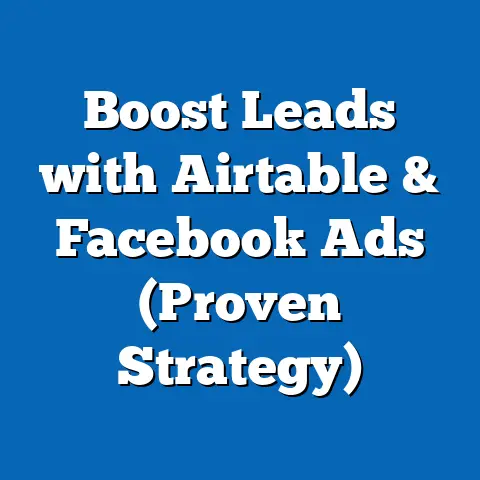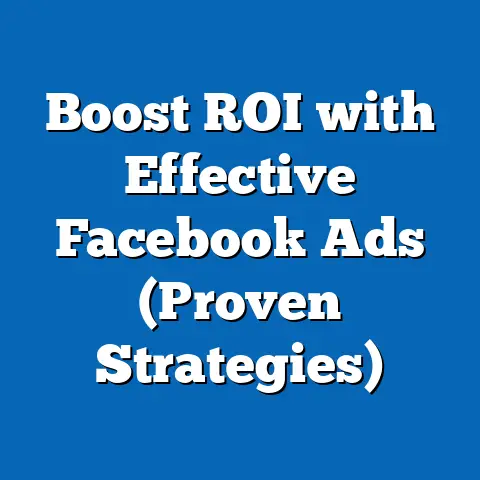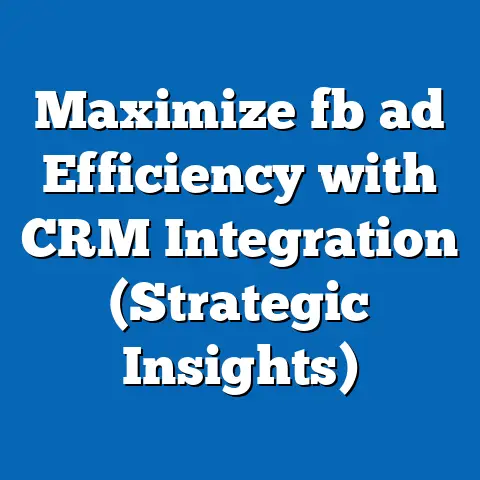Master Facebook Ads User Growth (Proven Strategies)
Facebook remains a powerhouse for businesses seeking to grow their user base. It’s where billions connect, share, and discover, making it fertile ground for attracting new customers. But simply launching a Facebook ad campaign isn’t enough. It requires a strategic approach, a keen understanding of your audience, and perhaps most importantly, a well-defined budget.
In this guide, I’ll delve into the proven strategies I’ve used and seen work time and again for driving user growth through Facebook Ads. We’ll explore the different budget options available, how to set a budget that aligns with your specific goals, and the essential tactics for targeting, creative development, retargeting, ad format selection, and campaign optimization. Think of this as your comprehensive playbook for turning Facebook Ads into a user acquisition engine.
Understanding Budget Options for Facebook Ads
Before diving into the nitty-gritty of campaigns, creatives, and targeting, let’s talk money. Understanding your budget options is the foundation of any successful Facebook Ads strategy. I’ve seen too many businesses throw money at ads without a clear understanding of how their budget is being allocated, leading to wasted spend and disappointing results.
Daily Budgets vs. Lifetime Budgets: Which is Right for You?
Facebook offers two primary budget options: daily budgets and lifetime budgets. Each has its advantages and disadvantages, and the best choice depends on your specific campaign goals and timeline.
-
Daily Budget: This allows you to set an average amount you’re willing to spend each day. Facebook will then attempt to spend around that amount, though it might fluctuate slightly based on algorithm optimization. I typically recommend daily budgets for ongoing campaigns that run without a fixed end date. For example, if you’re consistently promoting a new product or service, a daily budget ensures continuous visibility.
- Example: You set a daily budget of $20. Facebook might spend anywhere from $18 to $22 on any given day, but it will average out to $20 over the course of the week.
-
Lifetime Budget: This option allows you to set a total amount you’re willing to spend over the entire duration of your campaign. Facebook will then optimize your ad delivery to make the most of that budget within the specified timeframe. I find lifetime budgets particularly useful for campaigns with a specific start and end date, such as promoting a limited-time offer or event.
- Example: You set a lifetime budget of $500 for a campaign running for 10 days. Facebook will aim to spend that $500 evenly over the 10 days, but it might spend more on some days and less on others, depending on performance.
Key Takeaway: If you’re planning a long-term campaign with a consistent message, use a daily budget. For time-bound promotions, a lifetime budget offers better control and predictability.
Daily Budget: This allows you to set an average amount you’re willing to spend each day. Facebook will then attempt to spend around that amount, though it might fluctuate slightly based on algorithm optimization. I typically recommend daily budgets for ongoing campaigns that run without a fixed end date. For example, if you’re consistently promoting a new product or service, a daily budget ensures continuous visibility.
- Example: You set a daily budget of $20. Facebook might spend anywhere from $18 to $22 on any given day, but it will average out to $20 over the course of the week.
Lifetime Budget: This option allows you to set a total amount you’re willing to spend over the entire duration of your campaign. Facebook will then optimize your ad delivery to make the most of that budget within the specified timeframe. I find lifetime budgets particularly useful for campaigns with a specific start and end date, such as promoting a limited-time offer or event.
- Example: You set a lifetime budget of $500 for a campaign running for 10 days. Facebook will aim to spend that $500 evenly over the 10 days, but it might spend more on some days and less on others, depending on performance.
Key Takeaway: If you’re planning a long-term campaign with a consistent message, use a daily budget. For time-bound promotions, a lifetime budget offers better control and predictability.
Setting a Budget Based on Goals
The most common mistake I see is businesses setting an arbitrary budget without considering their goals. Your budget should be directly tied to your user growth objectives. Ask yourself:
- What are you trying to achieve? Are you aiming for brand awareness, lead generation, website traffic, or direct sales?
- How many new users do you want to acquire? Set a realistic target based on your historical data and market research.
- What’s the value of each new user? Understanding the lifetime value (LTV) of a customer will help you determine how much you can afford to spend to acquire them.
Once you have a clear understanding of your goals, you can start to estimate your budget. For example, if you want to acquire 100 new users and you estimate that your cost-per-acquisition (CPA) will be $10, you’ll need a budget of $1,000.
Cost Considerations: Understanding CPC and CPM
To effectively manage your budget, it’s crucial to understand the different cost metrics used in Facebook Ads. The two most common are:
- Cost-Per-Click (CPC): The amount you pay each time someone clicks on your ad. CPC is a good metric to track if you’re aiming to drive traffic to your website or landing page.
- Cost-Per-Mille (CPM): The amount you pay for every 1,000 impressions your ad receives. CPM is a good metric to track if you’re aiming to increase brand awareness.
Average CPC and CPM vary widely depending on factors such as industry, audience, ad quality, and competition. According to recent data, the average CPC on Facebook is around \$0.97, while the average CPM is around \$12.07. However, these are just averages, and your actual costs may be higher or lower.
Scaling Your Budget Strategically
Once you’ve launched your campaign and started seeing results, you might be tempted to immediately increase your budget. However, I recommend scaling your budget gradually and strategically.
- Start Small: Begin with a modest budget and monitor your results closely. This will allow you to identify any issues with your targeting, creative, or landing page before you invest too much money.
- A/B Test Budgets: Experiment with different budget levels to find the sweet spot where you’re maximizing ROI. For example, you could run two identical campaigns with different budgets and compare their performance.
- Gradual Increases: Increase your budget incrementally (e.g., 10-20% at a time) and monitor your results. If you see a significant drop in performance, reduce your budget back to its previous level.
-
Monitor Performance: Continuously track your key metrics (e.g., CPA, conversion rate) and adjust your budget accordingly. If you’re seeing good results, you can increase your budget. If you’re not, you need to re-evaluate your strategy.
Warning: Avoid making drastic budget changes, as this can disrupt the algorithm’s optimization process and negatively impact your results.
Monitor Performance: Continuously track your key metrics (e.g., CPA, conversion rate) and adjust your budget accordingly. If you’re seeing good results, you can increase your budget. If you’re not, you need to re-evaluate your strategy.
Warning: Avoid making drastic budget changes, as this can disrupt the algorithm’s optimization process and negatively impact your results.
Proven Strategies for User Growth Using Facebook Ads
Now that we’ve covered the essentials of budgeting, let’s move on to the core strategies for driving user growth with Facebook Ads.
Targeting the Right Audience: Precision is Key
One of the biggest advantages of Facebook Ads is its powerful targeting capabilities. You can reach specific groups of people based on their demographics, interests, behaviors, and connections. But with so many options, it’s easy to get overwhelmed.
- Demographic Targeting: Target users based on age, gender, education, relationship status, job title, and more. This is a good starting point for most campaigns.
- Interest-Based Targeting: Target users based on their interests, hobbies, and the pages they’ve liked on Facebook. This is a great way to reach people who are passionate about a particular topic.
- Behavioral Targeting: Target users based on their past behavior, such as their purchase history, device usage, and travel habits. This is particularly useful for reaching people who are likely to be interested in your product or service.
- Custom Audiences: Create custom audiences based on your existing customer data, such as email lists, website visitors, and app users. This allows you to target people who are already familiar with your brand.
-
Lookalike Audiences: Create lookalike audiences based on your custom audiences. This allows you to reach new people who are similar to your existing customers.
Personal Experience: I once worked with a local bakery that was struggling to attract new customers. By creating a custom audience based on their email list and then creating a lookalike audience, we were able to reach a much wider audience of people who were likely to be interested in their products. The result was a significant increase in sales.
Key Takeaway: Don’t rely on broad targeting. Use Facebook’s detailed targeting options to reach the people who are most likely to convert.
Lookalike Audiences: Create lookalike audiences based on your custom audiences. This allows you to reach new people who are similar to your existing customers.
Personal Experience: I once worked with a local bakery that was struggling to attract new customers. By creating a custom audience based on their email list and then creating a lookalike audience, we were able to reach a much wider audience of people who were likely to be interested in their products. The result was a significant increase in sales.
Key Takeaway: Don’t rely on broad targeting. Use Facebook’s detailed targeting options to reach the people who are most likely to convert.
Crafting Compelling Ad Creatives: Grab Attention and Drive Action
Even with the best targeting in the world, your ads will fail if they don’t capture attention and drive action. Your ad creatives are the first impression potential users have of your brand, so it’s essential to make them visually appealing and engaging.
- High-Quality Images and Videos: Use professional-quality images and videos that are relevant to your target audience and your offer. Avoid using stock photos that look generic.
- Clear and Concise Copy: Write copy that is easy to understand and highlights the benefits of your product or service. Use a strong headline that grabs attention and a clear call to action that tells people what you want them to do.
- Mobile-First Design: Design your ads for mobile devices, as the majority of Facebook users access the platform on their smartphones.
-
A/B Test Your Creatives: Experiment with different headlines, images, and calls to action to see what resonates best with your audience.
Pro Tip: I’ve found that using user-generated content (UGC) in ads can be highly effective. UGC is authentic and relatable, and it can help build trust with potential customers.
Key Takeaway: Invest in high-quality ad creatives that are visually appealing, engaging, and relevant to your target audience.
A/B Test Your Creatives: Experiment with different headlines, images, and calls to action to see what resonates best with your audience.
Pro Tip: I’ve found that using user-generated content (UGC) in ads can be highly effective. UGC is authentic and relatable, and it can help build trust with potential customers.
Key Takeaway: Invest in high-quality ad creatives that are visually appealing, engaging, and relevant to your target audience.
Utilizing Facebook Pixel for Retargeting: Bring Back Lost Leads
The Facebook Pixel is a small piece of code that you place on your website to track user behavior. It allows you to track things like page views, add-to-carts, and purchases. This data can then be used to create retargeting ads that bring back users who have previously interacted with your brand but didn’t convert.
- Website Retargeting: Show ads to people who have visited your website but didn’t make a purchase. Remind them of what they were looking at and offer them a special discount or incentive to complete the purchase.
- Abandoned Cart Retargeting: Show ads to people who added items to their cart but didn’t complete the checkout process. Remind them of the items they left behind and offer them free shipping or a discount to encourage them to complete the purchase.
-
Video Retargeting: Show ads to people who watched a certain percentage of your video. This is a great way to re-engage people who showed interest in your brand but didn’t take any further action.
Insight: Retargeting ads are often more effective than initial ads because they target people who are already familiar with your brand.
Key Takeaway: Install the Facebook Pixel on your website and use it to create retargeting ads that bring back lost leads and drive conversions.
Video Retargeting: Show ads to people who watched a certain percentage of your video. This is a great way to re-engage people who showed interest in your brand but didn’t take any further action.
Insight: Retargeting ads are often more effective than initial ads because they target people who are already familiar with your brand.
Key Takeaway: Install the Facebook Pixel on your website and use it to create retargeting ads that bring back lost leads and drive conversions.
Leveraging Facebook’s Ad Formats: Choose the Right Tool for the Job
Facebook offers a variety of ad formats, each with its strengths and weaknesses. Choosing the right ad format can significantly impact your campaign’s success.
- Image Ads: Simple and effective for driving traffic to your website or landing page.
- Video Ads: Highly engaging and effective for telling your brand’s story and showcasing your products or services.
- Carousel Ads: Allow you to showcase multiple products or services in a single ad.
- Collection Ads: Designed for mobile shopping, allowing users to browse and purchase products directly from the ad.
-
Lead Ads: Allow you to collect leads directly from Facebook without sending users to your website.
Example: A clothing retailer might use carousel ads to showcase their latest collection, while a SaaS company might use video ads to explain the benefits of their software.
Key Takeaway: Experiment with different ad formats to see what works best for your target audience and your campaign goals.
Lead Ads: Allow you to collect leads directly from Facebook without sending users to your website.
Example: A clothing retailer might use carousel ads to showcase their latest collection, while a SaaS company might use video ads to explain the benefits of their software.
Key Takeaway: Experiment with different ad formats to see what works best for your target audience and your campaign goals.
Analyzing and Optimizing Campaign Performance: Data-Driven Decisions
The final piece of the puzzle is analyzing and optimizing your campaign performance. This involves monitoring your key metrics, identifying areas for improvement, and making adjustments to your targeting, creatives, and budget.
- Track Your Key Metrics: Monitor metrics such as click-through rate (CTR), conversion rate, cost-per-acquisition (CPA), and return on ad spend (ROAS).
- Identify Areas for Improvement: Look for trends and patterns in your data. Are certain demographics or interests performing better than others? Are certain ad creatives generating more clicks or conversions?
- A/B Test Everything: Continuously experiment with different targeting options, ad creatives, and bidding strategies to see what works best.
-
Reallocate Your Budget: Focus your budget on the campaigns, ad sets, and ads that are performing the best.
Warning: Don’t make assumptions about what works best. Let the data guide your decisions.
Key Takeaway: Continuously monitor, analyze, and optimize your campaign performance based on data.
Reallocate Your Budget: Focus your budget on the campaigns, ad sets, and ads that are performing the best.
Warning: Don’t make assumptions about what works best. Let the data guide your decisions.
Key Takeaway: Continuously monitor, analyze, and optimize your campaign performance based on data.
Conclusion
Mastering Facebook Ads for user growth requires a combination of strategic planning, creative execution, and data-driven optimization. By understanding your budget options, targeting the right audience, crafting compelling ad creatives, leveraging retargeting, choosing the right ad formats, and continuously analyzing your campaign performance, you can turn Facebook Ads into a powerful user acquisition engine.
Remember that the landscape of Facebook advertising is constantly evolving. New features are introduced, algorithms change, and user behavior shifts. So, it’s crucial to stay up-to-date with the latest best practices and be willing to experiment and adapt your strategies as needed.
Don’t be afraid to test new things, analyze your results, and make adjustments along the way. The more you experiment and learn, the better you’ll become at driving user growth with Facebook Ads.
Call to Action
I hope this guide has provided you with valuable insights and actionable strategies for mastering Facebook Ads user growth. Now it’s time to put these strategies into practice.
For more in-depth guides and expert advice on digital marketing strategies, be sure to follow my blog. And if you have any questions or experiences with Facebook Ads you’d like to share, please leave a comment below. I’d love to hear from you!

